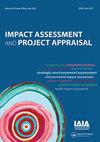Transformation towards a sustainable world – the pivotal role of impact assessments
IF 1.9
4区 社会学
Q3 ENVIRONMENTAL STUDIES
引用次数: 1
Abstract
Dear readers, Much has been written in the professional literature on what is required in order to realize a sustainable transformation of societies and economies. In this context, more recently, particular attention has been paid to the Sustainable Development Goals (SDGs; see, e.g. Kørnøv et al. 2020). The 17 SDGs work in different dimensions that, according to Sachs et al. (2019) can be expressed through the following six ‘modules’; ‘(1) education, gender and inequality; (2) health, well-being and demography; (3) energy decarbonization and sustainable industry; (4) sustainable food, land, water and oceans; (5) sustainable cities and communities; and (6) digital revolution for sustainable development’ (Sachs et al. 2019, abstract). Whilst all dimensions/modules are interlinked, some of the linkages are weaker whereas others are stronger. This is particularly true with regard to the operationalization of goals through policies and associated plans, programmes and projects. Whilst e.g. energy programmes may have a narrow focus on particular energy development options (and may thus mainly focus on module (3)), regional spatial strategies are likely going to touch on all of the above six modules (Fischer 2003). Furthermore, whereas SDGs are usually linked with targets and associated actions of implementation, there is a tendency to look at goals in isolation and the necessity to deal with possible trade-offs between different goals is (too) often ignored (Fischer 2020). In this context, integration has been portrayed as ‘the key to implementing the Sustainable Development Goals’ (Stafford-Smith et al. 2017, title). Importantly, there is a presumption that given suitable implementation instruments (more recently, the potential role of taxonomies of sustainable investment has been critically discussed in Impact Assessment and Project Appraisal – IAPA; see Dusík and Bond 2022; Fischer 2022), implementation of all goals is possible. However, this is an unrealistic expectation (Bowen et al. 2017), as trade-offs will always need to be dealt with in policy, plan, programme and project making. The pivotal role impact assessments (IAs) play for enabling operationalisation of SDGs and sustainable development, in particular by making trade-offs transparent, is unfortunately frequently ignored. Examples abound, including statements such as ‘we lack clear models for organizing [. . .] discussions and consultation processes’ and ‘Sophisticated tools are needed to design pathways [.] for Transformations’ (Sachs et al. 2019, p812). However, IA approaches are (and have already been for some time) providing for such models and tools (see, e.g. Morrison-Saunders et al. 2015; Geneletti 2016; Fischer and González, 2021; Fonseca 2022). In this context, suggestions that ‘new and improved tools are needed’ (Sachs et al. 2019, p812) without mentioning IA and not considering what is already available is highly problematic, as this will just contribute to further delays in the transformation towards sustainable societies and economies due to attempts to reinvent the wheel with arising solutions that – as past examples have shown – routinely look remarkably similar to what we already have, amongst which in the IA field (see, e.g. Fischer 2007). This is an important reason for why, despite the existence of 1,000s of scientific studies looking at the SDGs (Biermann et al, 2022), their ‘impact has been largely discursive, affecting the way actors understand and communicate about sustainable development [and that] more profound normative and institutional impact, from legislative action to changing resource allocation, remains rare’ (ibid, abstract). An important task of those advocating IA over the next decade will therefore need to be the generation of empirical evidence for how IA approaches help to achieve sustainable outcomes. Whilst there is some evidence available (e.g. Fischer and Retief, 2021; Van Eck and Scholten, 1997; Dipper 1998; Wende 2002; IEMA 2011; Jones and Fischer 2016; Rega et al. 2018), overall this remains pitifully limited. Hopefully, readers of this journal see this as an invitation for further work and for providing proof for the usefulness of IA. Subsequently, in this issue of IAPA, you find seven papers, written by a total of 29 authors. The first paper from Canada deals with issues of environmental impact assessment (EIA) follow-up in mining projects, elaborating on the problems generated by the deferral of important issues to post approval discussions. The second paper from South Africa discusses the recently introduced GIS-based EIA screening tool here, an instrument of EIA simplification, and provides for a critical reflection of some initial applications. The third paper from Brazil discusses problems with the application of social licenses to operate and in the fourth paper from Wales, health implications of challenges associated with climate change, COVID-19 and Brexit are assessed. The fifth paper from Mexico looks IMPACT ASSESSMENT AND PROJECT APPRAISAL 2023, VOL. 41, NO. 2, 85–86 https://doi.org/10.1080/14615517.2023.2171829向可持续世界转型——影响评估的关键作用
亲爱的读者们,专业文献中已经写了很多关于实现社会和经济可持续转型所需的内容。在这方面,最近特别关注可持续发展目标(SDG;例如,见Kørnøv等人,2020)。根据Sachs等人的说法,17个可持续发展目标在不同的维度上发挥作用。(2019)可以通过以下六个“模块”来表达(1) 教育、性别和不平等;(2) 健康、福祉和人口统计;(3) 能源脱碳和可持续工业;(4) 可持续的粮食、土地、水和海洋;(5) 可持续城市和社区;以及(6)可持续发展的数字革命”(Sachs等人,2019,摘要)。虽然所有维度/模块都是相互关联的,但其中一些关联较弱,而另一些关联较强。在通过政策和相关计划、方案和项目实现目标方面尤其如此。例如,虽然能源方案可能只关注特定的能源开发选项(因此可能主要关注模块(3)),但区域空间战略可能会涉及上述六个模块(Fischer 2003)。此外,尽管可持续发展目标通常与目标和相关的实施行动联系在一起,但人们倾向于孤立地看待目标,处理不同目标之间可能的权衡的必要性往往被忽视(Fischer 2020)。在这种情况下,一体化被描述为“实现可持续发展目标的关键”(Stafford-Smith等人,2017,标题)。重要的是,有一种假设是,如果有合适的实施工具(最近,可持续投资分类法的潜在作用在影响评估和项目评估IAPA中进行了批判性讨论;见Dusík和Bond 2022;Fischer 2022),所有目标的实施都是可能的。然而,这是一个不切实际的期望(Bowen等人,2017),因为在政策、计划、方案和项目制定中总是需要进行权衡。不幸的是,影响评估在实现可持续发展目标和可持续发展方面发挥的关键作用,特别是通过使权衡透明,经常被忽视。例子比比皆是,包括“我们缺乏组织[…]讨论和咨询过程的明确模型”和“需要复杂的工具来设计转型的途径[…]”(Sachs等人,2019,p812)。然而,IA方法正在(并且已经有一段时间了)提供此类模型和工具(例如,参见Morrison-Saunders等人2015;Geneletti 2016;Fischer和González,2021;丰塞卡2022)。在这种情况下,“需要新的和改进的工具”的建议(Sachs等人,2019,p812)没有提及IA,也没有考虑已经可用的工具,这是非常有问题的,因为这只会导致向可持续社会和经济转型的进一步延迟,因为人们试图用新兴的解决方案重新发明轮子,正如过去的例子所示,这些解决方案通常看起来与我们现有的非常相似,其中在IA领域(见,例如Fischer 2007)。这就是为什么尽管存在1000多项针对可持续发展目标的科学研究(Biermann et al,2022),但它们的影响在很大程度上是散漫的,影响了行动者理解和沟通可持续发展的方式[以及]更深刻的规范和制度影响,从立法行动到不断变化的资源分配,仍然罕见”(同上,摘要)。因此,倡导IA的人在未来十年的一项重要任务是为IA方法如何帮助实现可持续成果提供经验证据。虽然有一些可用的证据(例如,Fischer和Retief,2021;Van Eck和Scholten,1997;Dipper 1998;Wende 2002;IEMA 2011;Jones和Fischer 2016;Rega等人2018),但总体而言,这仍然非常有限。希望本杂志的读者能将此视为对进一步工作的邀请,并为IA的有用性提供证据。随后,在本期IAPA中,你会发现共有29位作者撰写的7篇论文。加拿大的第一份文件涉及采矿项目的环境影响评估后续行动问题,详细阐述了将重要问题推迟到批准后讨论所产生的问题。来自南非的第二篇论文讨论了最近引入的基于GIS的环境影响评价筛选工具,这是一种简化环境影响评价的工具,并对一些初步应用进行了批判性反思。来自巴西的第三篇论文讨论了运营社会许可证的应用问题,来自威尔士的第四篇论文评估了与气候变化、新冠肺炎和英国脱欧相关的挑战对健康的影响。
本文章由计算机程序翻译,如有差异,请以英文原文为准。
求助全文
约1分钟内获得全文
求助全文
来源期刊

Impact Assessment and Project Appraisal
ENVIRONMENTAL STUDIES-
CiteScore
4.60
自引率
22.70%
发文量
52
期刊介绍:
This is the international, peer-reviewed journal of the International Association for Impact Assessment (IAIA). It covers environmental, social, health and other impact assessments, cost-benefit analysis, technology assessment, and other approaches to anticipating and managing impacts. It has readers in universities, government and public agencies, consultancies, NGOs and elsewhere in over 100 countries. It has editorials, main articles, book reviews, and a professional practice section.
 求助内容:
求助内容: 应助结果提醒方式:
应助结果提醒方式:


